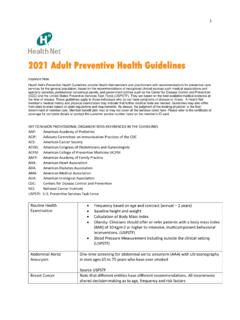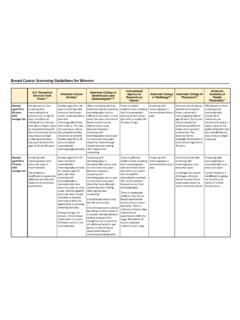Transcription of Consensus Guideline on Breast Cancer Lumpectomy Margins
1 - Official Statement - Consensus Guideline on Breast Cancer Lumpectomy Margins Purpose To provide an algorithm for re-excision surgery after Lumpectomy or Breast conservation for Breast Cancer (invasive and in-situ). Associated ASBrS guidelines or Quality Measures 1. Prior Consensus Statement: Position statement on Breast Cancer Lumpectomy Margins Revised January 16, 2013 2. Quality Measure: Specimen Orientation for Partial Mastectomy or Excisional Breast Biopsy Updated March 27, 2014 3. Guideline : Performance and Practice guidelines for Breast -Conserving Surgery-Partial Mastectomy Revised February 22, 2015 Methods Literature review inclusive of meta-analyses evaluating the impact of margin positivity on local recurrence rates, randomized controlled trials on rates of margin re-excision with technique, and large-sample retrospective reviews of data associated with margin re-excision.
2 This is not a complete systematic review but a comprehensive review of the modern literature on this subject. The ASBS Research Committee developed a Consensus document which was reviewed and approved by the ASBS Board of Directors. Summary of Data Reviewed 1. Margin status: The presence or absence of malignant cells on the edge or close to the edge of a partial mastectomy specimen is called the surgical margin status. This margin status serves as a surrogate marker of residual disease in the Breast and has an impact on patient risk of in- Breast tumor recurrence (IBTR). There is evidence of significant variation in margin definitions, positive margin rates, and re-excision Lumpectomy rates (RELR) in patients undergoing Surgeon opinion of a negative surgical margin ranges from ink negative to greater than 1 cm, providing one potential explanation for variation in surgical re-excision ,8-10,12,15-18 2.
3 Surgical specimen orientation: Indeterminate, high-risk, or confirmed Breast Cancer tissue specimens should have Margins oriented intraoperatively by the surgeon, accompanied by clear communication with pathology and After the 2 surgeon orients the specimen, the surgeon or pathologist should ink the Margins to identify the surfaces of the excised specimen. The operative report should document whether the specimen and fascia was removed from the muscle. The removal of any skin should also be noted. Nonpalpable, image- detected lesions require radiographic confirmation of excision by mammogram or ultrasound (US) to confirm removal of the targeted Resultant specimen imaging findings should be communicated intraoperatively to the surgeon and should also be available for the pathologist. The pa thologist should document grossly and microscopically the orientation, distance, and extent of involvement between the invasive and in situ Cancer for each specific margin, compliant with the College of American Pathologists (CAP) Breast Cancer reporting 3.
4 Tools and techniques to aide in limiting margin positivity: Multiple methods and techniques have been described to reduce the chance of microscopically positive Lumpectomy Margins . In 2015, the American Society of Breast Surgeons held a multidisciplinary Consensus conference entitled a Collaborative Attempt to Lower Lumpectomy Reoperation rates (CALLER) and composed a toolbox of options to reduce Lumpectomy Emerging technologies being developed for intraoperative margin assessment are undergoing clinical trials and evaluation and should not ideally add too much time to the surgery and should provide cost savings for improved efficacy to presently available technologies. 4. Positive Margins : Patients with invasive or in situ Breast carcinoma with histologic positive Margins (ink positive) after Lumpectomy have increased IBTR compared to patients with negative ,6,7,9,10,26 IBTR and local regional recurrence (LRR) after BCS for invasive Cancer can influence patient survival.
5 The Early Breast Cancer Trialists Collaborative Group (EBCTCG) concludes that 1 life is saved at 15-year follow-up for every 4 local recurrences prevented at 10 years after Re-excision to achieve negative Margins is therefore desirable and should be performed in most patients with ink-positive Margins . Many factors, including patient age, co-morbidities, life expectancy, extent of excision, extent of margin involvement, tumor characteristics, and whether the patient will receive adjuvant therapies, should be taken into account before proceeding with re- excision. The margin index, based on margin status and tumor extent at the margin, may assist prediction of residual malignancy in the ,29 Re-excision may not be necessary for involved anterior and posterior Margins if underlying muscle fascia or overlying skin has been removed. If re-excision is not performed for a positive margin, then the reason should be documented in the medical record.
6 5. Negative and close Margins : When Margins are ink-negative, there is variation of opinion of adequacy of margin width that does not require re-excision, resulting in differences of definition and practice among surgeons, pathologists, and radiation ,3,8,9,12,15 In the 1970s, the National Surgical Adjuvant Breast and Bowel Project (NASBP) B-06 study defined a negative margin as no tumor cells found on the inked edge of a surgical In a recent meta-analysis, the effect of margin status and margin distance on IBTR in patients with early-stage invasive Breast Cancer was evaluated in 21 studies that identified 1026 local recurrences in 14,571 The odds ratio for recurrence was (P < ) for positive vs negative Margins . Greater 3 radial width of a negative margin had borderline significance for improvement in LRR for 1 mm compared to wider Margins , but no significance when adjusted for patients receiving a radiation boost or endocrine Current ASCO/SSO/ASTRO and NCCN guidelines recommend using no ink on the tumor as a definition of negative margin for invasive Breast Cancer (with or without DCIS) undergoing Lumpectomy with whole Breast ,31 On the other hand, in a meta-analysis from trials evaluating BCS and radiation therapy for DCIS in 4,660 patients concluded that a 2-mm margin was not associated with decreased IBTR, compared to more than 2 Recent ASCO/SSO/ASTRO Consensus and current NCCN guidelines recommend that Margins for pure DCIS (with or without microinvasion)
7 Treated with Lumpectomy and radiation should be at least ,32 However, close surgical Margins (<1 mm) at the fibroglandular boundary of the Breast (chest or skin) do not mandate surgical re-excision but can be an indication for higher boost dose radiation to the involved Lumpectomy site. 18 The value of re-excision is unclear after BCS for patients with invasive Breast Cancer when Margins are negative, but close (<1-2 mm) if these patients receive appropriate adjuvant radiation and systemic Similarly, there is insufficient evidence to support re-excision of DCIS for Margins wider than 2mm. If re-excision is performed in these cases, then the reason for re -excision should be documented in the medical record. Justifiable reasons could include, but are not limited to (1) residual adjacent malignant appearing calcifications identified on post- Lumpectomy mammography, (2) an ink-negative margin but proximate large volume Cancer involvement within 1-2 mm of the margin, and (3) fragmented Lumpectomy specimens, causing uncertainty of margin status.
8 Avoiding re-excisions to obtain wider Margins in patients with documented negative margin status can potentially lower RELR 6. Impact of adjuvant therapies on Margins : Historically the risk of IBTR has been decreasing, probably due more to improved adjuvant treatments than to changes in patient management regarding margin status, because re- excision of ink- positive Margins has been usual practice for decades. With better understanding of the influence of molecular and genomic profiling on tumor behavior and the introduction of targeted therapies, width of negative margin status becomes only one of many factors that govern local recurrence. Moreover, it is widely recognized that not all Breast Cancer is removed in many patients undergoing BCS, even with negative Margins . Histopathology research demonstrates that only about one third of Breast cancers are unifocal; the rest are multifocal or ,33 Breast MRI finds some of these cancers.
9 Comprehensive histology finds even more. These extra sites of Cancer are usually controlled with adjuvant therapies, as evidenced by the low IBTR in trial patients receiving adjuvant endocrine therapy, chemotherapy, and radiation therapy after ,34-36 7. Using re-excision Lumpectomy rate a measure of quality: The use of margin status and RELR as a measure of quality is ,9,14,15 RELR ranges from 0% to 70% (by individual surgeon) in the United Recent publications also document wide variability in Canada (17-56% by province) and England (12%-30% by National Health Service trust).14,15 The European Society of Breast Cancer Specialists (EUSOMA), the National Consortium of Breast Centers (NCBC), and multiple institutions use RELR as a quality measure (QM).4,14,15,38-43 Arguments against the use of RELR as a QM include (1) 4 the lack of evidence defining the minimum or optimal quality threshold for RELR, and (2) the concern that unintended adverse consequences may occur if the importance of RELR is elevated too high by using it as a QM.
10 For example, surgeons may demonstrate risk aversion, changing their criteria for eligibility for Breast -conserving therapy, in patients with inherently high risk for positive Margins , increasing mastectomy rates, in their effort to lower RELR. Surgeons may also potentially increase their Lumpectomy excisional volume, worsening cosmesis. Despite these concerns, RELR as a QM is already in use as referenced above. The American Society of Breast Surgeons advises caution in the use of RELR as a QM. If RELR is used as a quality measurement tool, then it should be incorporated into a program that simultaneously measures other aspects of BCS quality, such as cosmetic outcome, patient satisfaction, IBTR, and Breast - conserving therapy ,42,44 International variability of the performance of RELR deserves investigation, but RELR should not be used as the singular determinant of the quality of BCS.




